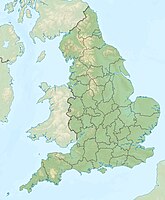Straight point
| Straight Point, Devon | ||
 View across Sandy Bay to Straight Point |
||
| Geographical location | ||
|
|
||
| Coordinates | 50 ° 36 '24 " N , 3 ° 21' 42" W | |
| Waters 1 | English Channel | |
Straight Point is a headland on the Channel coast near Exmouth in the county of Devon in southwest England .
location
Straight Point is about sixteen kilometers south of the city of Exeter , four kilometers southeast of Exmouth and about eleven kilometers southwest of Sidmouth . Sandy Bay stretches west of Straight Point , with Orcombe Point at its western end . On the east side of Straight Point is Otter Cove and a little further east is the village of Budleigh Salterton .
The Straight Point headland is used by the Marines as a firing range.
geology
The steep coast of the English Channel in East Devon and Dorset is one of the natural wonders of the world. From Orcombe Point to Old Harry Rocks , a 155 km long coastline, the first country in the UK by extending UNESCO for World Heritage declared. Straight Point is part of this so-called Jurassic Coast .
The Jurassic Coast rock strata tilts slightly to the east. The geologically oldest rocks are therefore in the westernmost section of this coastal geotope . The mean age of the rocks gradually decreases towards the east. The natural outcrops along the coast form a largely continuous sequence, ranging from deposits of the Triassic , through those of the Jura to those of the Cretaceous period, and represents a geological period totaling around 185 million years. The storage room that received the sediment series from the Jurassic Coast at that time is the so-called Wessex Basin .
Orcombe Point is the starting point for the "walk through time", the march through time along the Jurassic Coast and Straight Point is only a few kilometers further east. Therefore, you are still in the geologically oldest part of the Jurassic Coast.
The red rocks on the cliffs at Straight Point consist of layers that are lithostratigraphically called "Exmouth Mudstone and Sandstone Formation" (roughly translatable as "Exmouth Clay and Sandstone Formation"), and which in turn form the "Aylesbeare Mudstone." Group ”(“ Alyesbeare Tonstein Group ”). The Exmouth Formation generally consists of red-brown silty claystones in which lenses of red-brown sandstone are inserted, which were deposited in a river plain under semi-arid to semi-humid climatic conditions in the late Permian and / or in the early Triassic . The Exmouth Formation is closely related to some important Permian and Triassic sedimentary series in Central Europe, both in terms of its origin, its age and its petrography . B. with the Tambach formation of the Thuringian Forest or the red sandstone, which is widespread in Germany .
The sequence in the cliff of Straight Point is part of the type profile of the Exmouth Formation.
At Straight Point, the proportion of sandstones in the sequence of the Exmouth Formation is particularly high. The fact that these sandstones can withstand the abrasive effects of waves and surf better than the mudstones that predominantly build the cliffs west and east of Straight Point is ultimately the reason why this headland was able to arise in the first place. Due to the relatively high resistance to erosion of these sandstones, a narrow surf platform has formed just above the ebb level on the south and east sides of Straight Point .
See also
Individual evidence
- ^ Dorset and East Devon Coast . UNESCO World Heritage Center. 2001. Retrieved October 19, 2010.
- ↑ a b Data sheet of the Exmouth Mudstone and Sandstone Formation in the British Geological Survey's online encyclopedia of named rock units
- ↑ Detlef Mader: Braidplain, floodplain and playa lake, alluvial-fan, aeolian facies and palaeosol composing a diversified lithogenetical sequence in the permian and triassic of South Devon (England) . In: Aspects of Fluvial Sedimentation in the Lower Triassic Buntsandstein of Europe. Lecture Notes in Earth Sciences . tape 4/1985 , 1985, pp. 15-64 , doi : 10.1007 / BFb0010515 .

